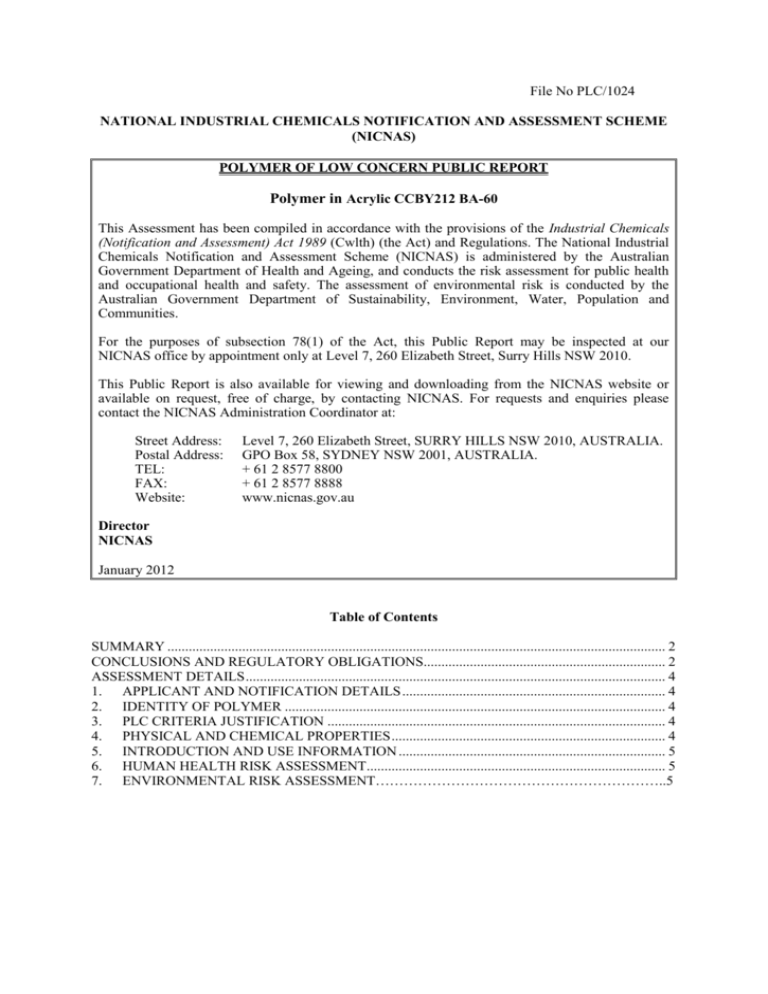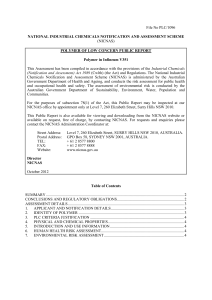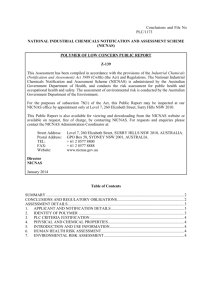assessment details
advertisement

File No PLC/1024 NATIONAL INDUSTRIAL CHEMICALS NOTIFICATION AND ASSESSMENT SCHEME (NICNAS) POLYMER OF LOW CONCERN PUBLIC REPORT Polymer in Acrylic CCBY212 BA-60 This Assessment has been compiled in accordance with the provisions of the Industrial Chemicals (Notification and Assessment) Act 1989 (Cwlth) (the Act) and Regulations. The National Industrial Chemicals Notification and Assessment Scheme (NICNAS) is administered by the Australian Government Department of Health and Ageing, and conducts the risk assessment for public health and occupational health and safety. The assessment of environmental risk is conducted by the Australian Government Department of Sustainability, Environment, Water, Population and Communities. For the purposes of subsection 78(1) of the Act, this Public Report may be inspected at our NICNAS office by appointment only at Level 7, 260 Elizabeth Street, Surry Hills NSW 2010. This Public Report is also available for viewing and downloading from the NICNAS website or available on request, free of charge, by contacting NICNAS. For requests and enquiries please contact the NICNAS Administration Coordinator at: Street Address: Postal Address: TEL: FAX: Website: Level 7, 260 Elizabeth Street, SURRY HILLS NSW 2010, AUSTRALIA. GPO Box 58, SYDNEY NSW 2001, AUSTRALIA. + 61 2 8577 8800 + 61 2 8577 8888 www.nicnas.gov.au Director NICNAS January 2012 Table of Contents SUMMARY ............................................................................................................................................ 2 CONCLUSIONS AND REGULATORY OBLIGATIONS.................................................................... 2 ASSESSMENT DETAILS ...................................................................................................................... 4 1. APPLICANT AND NOTIFICATION DETAILS .......................................................................... 4 2. IDENTITY OF POLYMER ........................................................................................................... 4 3. PLC CRITERIA JUSTIFICATION ............................................................................................... 4 4. PHYSICAL AND CHEMICAL PROPERTIES ............................................................................. 4 5. INTRODUCTION AND USE INFORMATION ........................................................................... 5 6. HUMAN HEALTH RISK ASSESSMENT.................................................................................... 5 7. ENVIRONMENTAL RISK ASSESSMENT……………………………………………………..5 January 2012 NICNAS SUMMARY The following details will be published in the NICNAS Chemical Gazette: ASSESSMENT APPLICANT(S) REFERENCE PLC/1024 Akzo Nobel Car Refinishes Australia Pty Ltd CHEMICAL OR HAZARDOUS INTRODUCTION TRADE NAME SUBSTANCE VOLUME Polymer in Acrylic CCBY 212 BA-60 No ≤ 20 tonnes per annum USE Surface Coatings CONCLUSIONS AND REGULATORY OBLIGATIONS Human Health Risk Assessment Based on the assumed low hazard and the assessed use pattern, the notified polymer is not considered to pose an unreasonable risk to the health of workers and the public. Environmental Risk Assessment Based on the assumed low hazard and the assessed use pattern, the notified polymer is not considered to pose an unreasonable risk to the environment. Health and Safety Recommendations No toxicological data were submitted. The notified polymer meets the PLC criteria and is therefore assumed to be of low hazard. The risk of the notified polymer to occupational and public health is not considered to be unreasonable given the assumed low hazard and the assessed use pattern. Environmental Recommendations No specific control measures are required to minimise release of the notified polymer to the environment. Disposal The notified polymer should be disposed to landfill. Storage The following precautions should be taken by workers regarding storage of the notified polymer: − Store in a segregated and approved area. − Store in original container protected from direct sunlight in a dry, cool and well ventilated area, away from incompatible materials (oxidising substances, strong acids, strong bases). Emergency Procedures Spills and/or accidental release of the notified polymer should be handled by physical containment, collection and subsequent safe disposal. Secondary Notification This risk assessment is based on the information available at the time of notification. The Director may call for the reassessment of the polymer under secondary notification provisions based on changes in certain circumstances. Under Section 64 of the Industrial Chemicals (Notification and Assessment) Act (1989) the notifier, as well as any other importer or manufacturer of the notified PUBLIC REPORT: PLC/1024 Page 2 of 5 January 2012 polymer, have post-assessment regulatory obligations to notify NICNAS when any of these circumstances change. These obligations apply even when the notified polymer is listed on the Australian Inventory of Chemical Substances (AICS). Therefore, the Director of NICNAS must be notified in writing within 28 days by the notifier, other importer or manufacturer: (1) Under Section 64(1) of the Act; if the notified polymer is introduced in a chemical form that does not meet the PLC criteria. or (2) Under Section 64(2) of the Act; if the function or use of the notified polymer has changed from a component of surface coatings, or is likely to change significantly; the amount of notified polymer being introduced has increased per annum, or is likely to increase, significantly; the notified polymer has begun to be manufactured in Australia; additional information has become available to the person as to an adverse effect of the notified polymer on occupational health and safety, public health, or the environment. The Director will then decide whether a reassessment (i.e. a secondary notification and assessment) is required. Material Safety Data Sheet The MSDS of the notified polymer containing the notified polymer was provided by the applicant. The accuracy of the information on the MSDS remains the responsibility of the applicant. PUBLIC REPORT: PLC/1024 Page 3 of 5 January 2012 ASSESSMENT DETAILS 1. APPLICANT AND NOTIFICATION DETAILS Applicants Akzo Nobel Car Refinishes Australia Pty Ltd (ABN: 26 087 571 882) 269 Williamstown Road, Port Melbourne, Victoria 3207 Exempt Information (Section 75 of the Act) Data items and details claimed exempt from publication: chemical name, other names, CAS number, molecular and structural formulae, molecular weight, polymer constituents, residual monomers/impurities. 2. IDENTITY OF POLYMER Marketing Name(s) Polymer in Acrylic CCBY 212 BA-60 Molecular Weight Number Average Molecular Weight (Mn) is > 1,000 Da Reactive Functional Groups The notified polymer contains only low concern functional groups. 3. PLC CRITERIA JUSTIFICATION Criterion Molecular Weight Requirements Functional Group Equivalent Weight (FGEW) Requirements Low Charge Density Approved Elements Only Stable Under Normal Conditions of Use Not Water Absorbing Not a Hazard Substance or Dangerous Good Criterion met Yes Yes Yes Yes Yes Yes Yes The notified polymer meets the PLC criteria. 4. PHYSICAL AND CHEMICAL PROPERTIES Appearance at 20°C and 101.3 kPa Melting Point/Glass Transition Temp Density Water Solubility Dissociation Constant Particle Size Reactivity Degradation Products PUBLIC REPORT: PLC/1024 Liquid Not applicable Approx 1,000 kg/m3 at 20°C 4.3 x 10-6 g/L at 25°C (Calculated for a representative low molecular weight oligomer by Episuite-WSKOW v1.41) Not applicable Not applicable Stable under normal use conditions. Not known Page 4 of 5 January 2012 5. INTRODUCTION AND USE INFORMATION Maximum Introduction Volume of Notified Chemical (100%) Over Next 5 Years Year Tonnes 1 2 3 4 5 10-20 10-20 10-20 10-20 10-20 Use The notified polymer will not be manufactured in Australia. The notified polymer will be imported into Australia at a concentration of ≤ 6%. Products containing the notified polymer will not be reformulated in Australia. The notified polymer will be used as a component of finished automotive refinish paint products at a concentration of ≤ 6%. 6. HUMAN HEALTH RISK ASSESSMENT No toxicological data were submitted. The notified polymer meets the PLC criteria and is therefore assumed to be of low hazard. The risk of the notified polymer to occupational and public health is not considered to be unreasonable given the assumed low hazard and the assessed use pattern. 7. ENVIRONMENT RISK ASSESSMENT No ecotoxicological data were submitted. Polymers without significant ionic functionality are generally of low concern to the environment. During use of the notified polymer as a component of automotive refinish paint products in industrial settings, up to 2% of the annual import volume may be released as spills, container residues, container and equipment washings and waste material. These releases are expected to be collected and sent to a licensed hazardous waste facility for disposal in accordance with state/territory waste standards. The main release (up to 40% as overspray during use) will typically entail landfill disposal, after interception by spray booth filters. Discarded end use articles containing the notified polymer within the cured paint film will be disposed to landfill, or recycled for metals reclamation which will entail thermal decomposition of the paint to form oxides of carbon and water vapour. In landfill, the notified polymer will be present as high molecular weight solids which will be neither bioavailable nor mobile. Therefore, based on its assumed low hazard and assessed use pattern, the notified polymer is not considered to pose an unacceptable risk to the environment. PUBLIC REPORT: PLC/1024 Page 5 of 5










